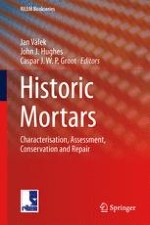2012 | OriginalPaper | Buchkapitel
Nineteenth Century “Novel” Building Materials: Examples of Various Historic Mortars Under the Microscope
verfasst von : Johannes Weber, Karol Bayer, Farkas Pintér
Erschienen in: Historic Mortars
Verlag: Springer Netherlands
Aktivieren Sie unsere intelligente Suche, um passende Fachinhalte oder Patente zu finden.
Wählen Sie Textabschnitte aus um mit Künstlicher Intelligenz passenden Patente zu finden. powered by
Markieren Sie Textabschnitte, um KI-gestützt weitere passende Inhalte zu finden. powered by
